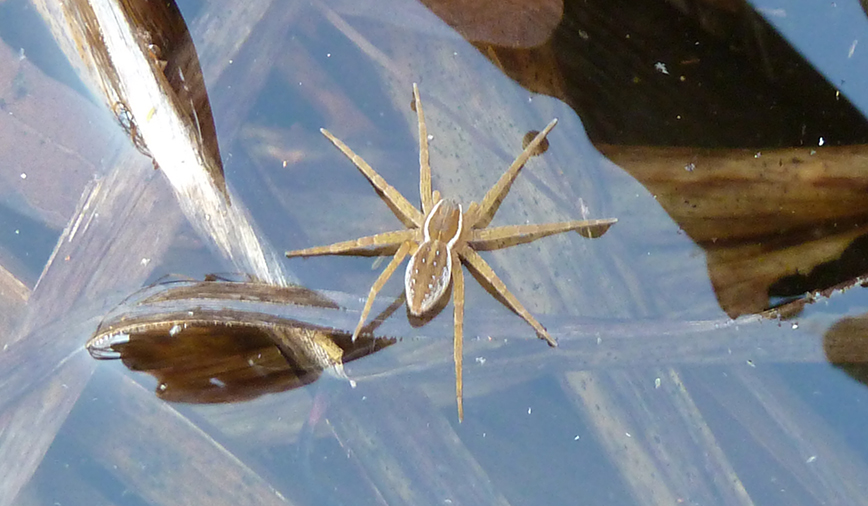With the explosion of color that spring brings—the woodland wildflowers, the migrating warblers, the sheer greenness of the land—it’s only natural that some of us would be seeing spots before our eyes. I know I am. Lots of spots, in fact. Paired symmetrically along the back of Dolomedes triton, the six-spotted fishing spider.
I encountered this young girl a few weeks ago during an exploration of the pothole wetlands that lie within the Hickory Knolls Natural Area. She looked particularly fetching that warm afternoon, displaying a certain freshness to her markings—and with good reason. Floating on the water’s surface not three feet away was a recently cast spider exuvia—the molted “skin,” or exoskeleton, of this eight-legged beauty.
(Side note: I don’ t know if you’ve ever examined a spider’s shed, but they really are a marvel to behold. That tough outer cuticle encloses not just the main body parts, the cephalothorax, abdomen and legs, but also the spider’s mouthparts and eyes. So when you look at the empty shell, you’ll be able to see the chelicerae, a.k.a fangs, as well as the eye arrangement—a characteristic important for identification. The next time you’re gazing upon a supposedly dead spider, high up in a little-used corner, consider the possibility that that “body” is really just a shed skin. Then the real fun can begin—that is, looking for the bigger, brighter spider that most certainly is lurking nearby.)
So, anyway, back to the fishing spider. D. triton—and don’t you just love the reference to the Greek god of the sea—is a member of the family Pisauridae, the nursery-web spiders.
What a great name. Can’t you just picture a baby spider nursery? Tiny mobiles of insects encased in silk, gently turning above cradles of web. Teensy spiderlings, their eight eyes glinting, reaching tentatively upward with a forelimb, or two. And momma spider, protectively standing watch over her brood of about 500. Or more.
Okay, so maybe that image doesn’t tug at the heartstrings the way a nest of robins or baby bunnies might. But the maternal instincts of a female fishing spider outpace those of robins and rabbits most any day. Pisauridae are in a class by themselves.
Rather than spinning a web and depositing eggs in a silken sac, as most other spiders do, the female fishing spider suspends her egg case between her large chelicerae, selflessly sacrificing her ability to hunt while the eggs incubate. Then, as they near hatching, she spins that nursery web, a messy but sturdy structure where her offspring will spend their first few days.
If set to music, this part of the spider’s life cycle would no doubt be accompanied by lullabies. Babies popping out of their eggs, stretching their legs, gazing in wonder at the world around them. Momma spider, still forgoing food, warding off threats to her family’s well-being.
Soon though, the soundtrack would change. The lilting strains of cradlesongs would be replaced by the strident tones of the theme from Jaws.
As the spiderlings begin to move about, the more robust individuals begin to dominate. Duunn dunnn…duuuunnn dunnn… Given some sort of instinctive edge, they begin to test their hunting skills. Dun dun dun dun dun dun dun dun… Quick as lightning, they strike, swiftly subduing their less-vigorous webmates. In a moment, the deed is done. The total number of offspring goes down, but the fitness of the survivors improves. These are spiders, after all.
Perhaps at the expense of several siblings, the young spider I found the other day was well on her way to adulthood. Though not yet old enough to spin a nursery web of her own, she’d just molted, and her new body length measured about half an inch. Mature females, by contrast, are usually an inch or more—and that doesn’t include the legs, which can spread an inch or more in each direction.
Such dimensions may be scary for arachnophobes, but they’re ideal for overpowering prey. These spiders consume an impressive diet that includes insects, tadpoles and small fish, and have been known to eat as much as five times their body weight in a single day.
I plan to head back to the wetlands some day soon. I don’t know that I’ll be lucky enough to spot this particular spider again; the potholes are pretty large, and fishing spiders, even at maturity, are small when compared to the cattails, reeds and grasses that dominate the area. But there’s bound to be more than one six-spotted fishing spider out there. And I’m determined to keep looking—til spots appear before my eyes.
Pam Otto is the manager of nature programs and interpretive services at the Hickory Knolls Discovery Center, a facility of the St. Charles Park District. She can be reached at 630-513-4346 or potto@stcparks.org.

